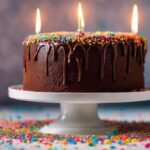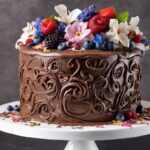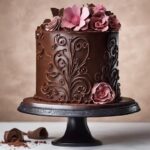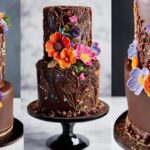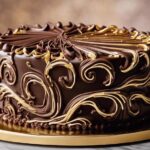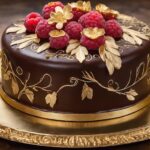Raw Food Ingredients
Guide to Ultimate Chocolate Cake Decoration Ideas
Create stunning chocolate cake decorations with chocolate curls, buttercream swirls, and more – elevate your decorating game with these ultimate ideas.
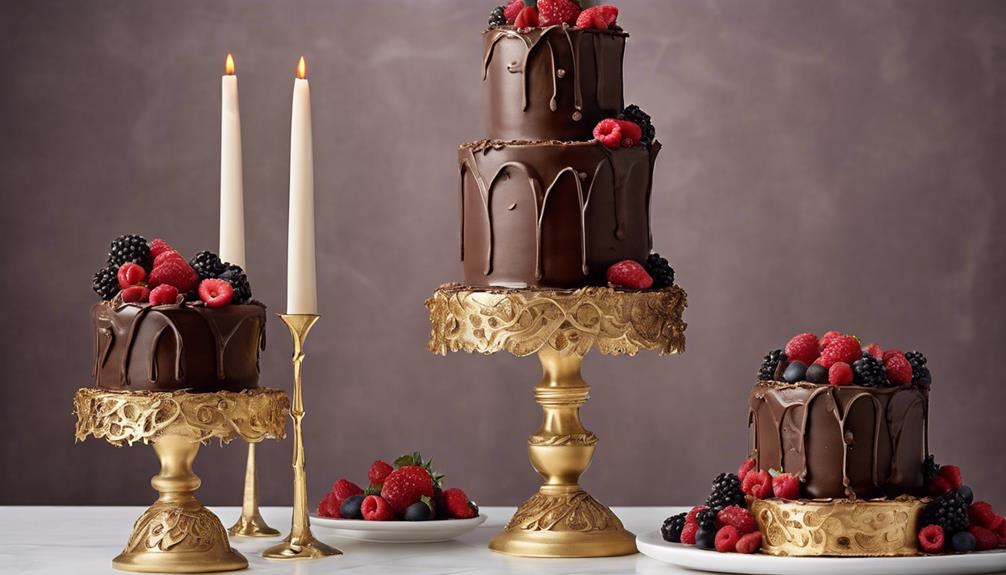
To elevate your chocolate cake decorating skills, give these top-notch ideas a try. Begin by making chocolate curls by spreading melted chocolate and scraping it for a gorgeous touch. Sprinkle some fun with chocolate jimmies in different colors and sizes. Seal in any crumbs and achieve a smooth base using the crumb coat technique to give it a refined appearance. Get imaginative with buttercream swirls by experimenting with various methods. Enhance your cake with fresh berry toppings to add both color and flavor.
Experiment with blossom-shaped truffles and edible glitter sparkle for eye-catching designs. Explore ganache drips for added visual appeal and personalized cake toppers to make your creation special. Elevate your baking skills with these expert techniques for stunning cake decorations.
Key Takeaways
- Experiment with chocolate curls for versatile and visually appealing cake decorations.
- Use chocolate jimmies to add colorful and creative touches to your cakes.
- Master the crumb coat technique for a flawless and polished cake finish.
- Enhance cake decoration with buttercream swirls for a decorative touch.
- Elevate your cakes with fresh berries, blossom-shaped truffles, edible glitter, and personalized toppers.
Chocolate Curls for Cake Decoration
To create stunning chocolate curls for cake decoration, start by spreading melted chocolate on a flat surface and carefully scraping it with a knife at an angle. This technique is a game-changer when it comes to visually enhancing a cake. The versatility of chocolate curls allows for endless creativity in decorating a cake. Whether you're aiming for a classic and elegant look or a more modern and artistic design, chocolate curls can elevate the overall appeal of your creation.
Adding chocolate curls to a cake not only makes it visually appealing but also adds a touch of sophistication. The process of making these curls might seem intricate, but once you get the hang of it, decorating with chocolate curls will become second nature. Experiment with different types of chocolate to find the perfect match for your cake, ensuring a harmonious blend of flavors and aesthetics.
Incorporating chocolate curls into your cake decoration repertoire is sure to impress your guests and make your desserts stand out from the crowd.
Incorporating Chocolate Jimmies

When adorning cakes with a playful and colorful touch, incorporating chocolate jimmies offers a delightful way to enhance the visual appeal of your desserts. Chocolate jimmies, those small rod-shaped chocolate sprinkles, bring a fun and vibrant element to your cake decoration repertoire. These versatile sprinkles come in various sizes, colors, and flavors, allowing for a burst of creativity when embellishing your chocolate cakes and desserts.
You can sprinkle chocolate jimmies generously on top of frosting for a classic look or mix them into the batter to create a speckled effect that surprises with every bite. For those feeling artistic, these jimmies can be used to outline intricate designs on your cakes, adding a touch of sophistication to your creations. Whether you're aiming for a simple yet effective decoration or looking to reveal your inner artist, chocolate jimmies are a must-have in your cake decorating arsenal. Let your imagination run wild as you explore the endless possibilities these tiny sprinkles bring to your chocolate masterpieces.
Applying a Crumb Coat Technique
Why consider applying a crumb coat technique when frosting a cake? Well, let me tell you, it's a game-changer in the world of cake decorating. Here's why:
- By applying a crumb coat, you create a smooth base for the final frosting layer, ensuring a flawless finish.
- This technique seals in crumbs, preventing them from mixing into the final frosting and giving your cake a polished look.
- Not only does the crumb coat keep your cake looking clean, but it also adds stability to the layers, making it easier to work with.
- To apply a crumb coat, simply spread a thin layer of frosting over the entire cake, refrigerate briefly to set it, and then add your final frosting layer.
In the world of cake decoration, the crumb coat is like the foundation of a house – it provides the necessary support and structure for a beautiful end result. Trust me, once you master this technique, your cakes will look like they came straight out of a bakery!
Creating a Swirl With Buttercream
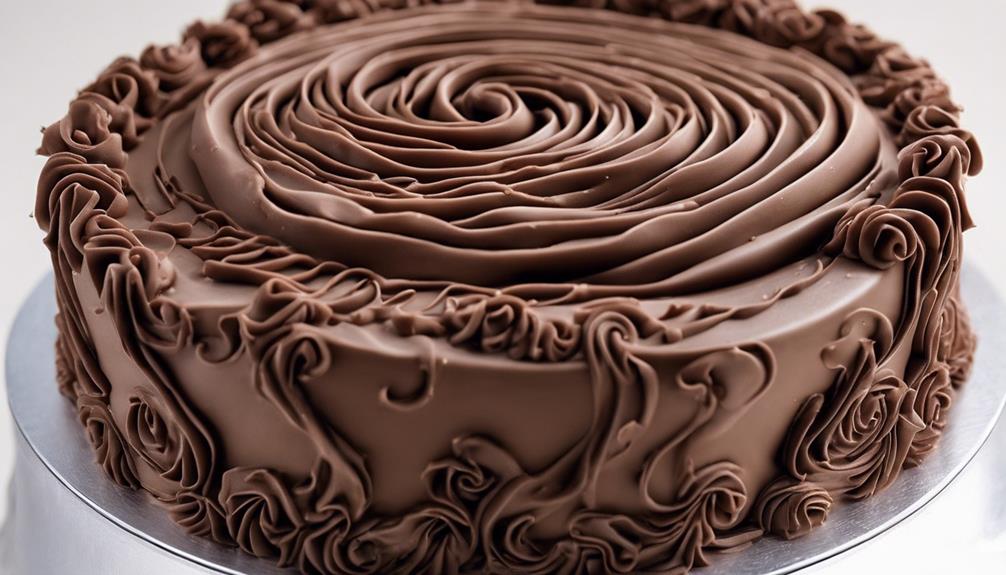
After mastering the crumb coat technique, creating a swirl with buttercream is the next step in elevating your chocolate cake decoration skills.
To start, generously apply chocolate buttercream on top of the cake. Using an offset icing spatula, begin swirling the buttercream in a circular motion from the center towards the edges. This technique helps create a beautiful swirl pattern on the cake's surface.
Keep swirling until you achieve the desired texture and design. The swirl adds a lovely decorative touch to your chocolate cake, and you can further enhance it with chocolate curls or sprinkles for added flair.
Experiment with different swirling techniques to create unique designs and textures that will impress your guests. Practice is key to mastering this skill, so don't be afraid to try out various swirling patterns to find what works best for your cake.
Using Fresh Berries as Toppers
Fresh berries offer a vibrant touch to chocolate cakes, elevating their appearance and taste. Select ripe, plump berries like strawberries, raspberries, blueberries, or blackberries for the best effect.
Arranging these berries creatively on top of the cake can add a pop of color and elegance to your dessert presentation.
Berry Selection Tips
When selecting fresh berries to use as cake toppers, opt for ripe, firm, and brightly colored varieties for a vibrant and visually appealing decoration. Here are some tips to help you choose the perfect berries for your Ultimate Chocolate Cake:
- Variety: Use a mix of strawberries, raspberries, blueberries, and blackberries for a colorful assortment.
- Preparation: Wash and dry the berries gently before placing them on the cake to guarantee cleanliness and freshness.
- Arrangement: Artfully place the berries on top of the cake or around the edges for an eye-catching presentation.
- Enhancement: Fresh berries not only add a burst of flavor but also a touch of elegance to your rich chocolate cake, elevating both taste and visual appeal.
Arranging Berries Artistically
For a visually stunning chocolate cake presentation, consider arranging fresh berries artistically as vibrant and delicious cake toppers. Mixing strawberries, raspberries, blueberries, and blackberries on top of your chocolate cake layers can create a burst of color that is visually appealing. To achieve a vibrant and varied look, vary the sizes and colors of the berries in your arrangement. This variation not only enhances the aesthetic appeal of the cake but also provides a fruity contrast to the rich chocolate flavor. By carefully arranging the fresh berries in an artistic pattern, you can elevate the overall look of your chocolate cake and impress your guests with both its appearance and taste.
| Berry Type | Size |
|---|---|
| Strawberries | Large |
| Raspberries | Small |
| Blueberries | Medium |
| Blackberries | Varies |
Edible Flower Decorations

When decorating a chocolate cake with edible flowers, consider using floral cupcake toppers, chocolate rose petals, or blossom-shaped truffles for a stunning presentation.
Make sure the flowers are safe to eat by verifying they're pesticide-free and edible before placing them on the cake.
Edible flowers not only add a touch of elegance but also provide a vibrant burst of color to your chocolate cake decorations.
Floral Cupcake Toppers
Adding a touch of elegance and beauty to chocolate cakes are floral cupcake toppers, exquisite edible flower decorations.
- Choose from a variety of edible flowers like pansies, violets, roses, or lavender to create stunning and romantic cake designs.
- These delicate flower decorations are safe for consumption and can be placed directly on the cake or cupcakes.
- Opt for organically grown and pesticide-free flowers to guarantee a safe and visually appealing cake decoration.
- Floral cupcake toppers are versatile for occasions like weddings or birthdays, adding a sophisticated flair to your dessert.
Chocolate Rose Petals
Delicately dipped in rich melted chocolate, rose petals transform into exquisite edible decorations that elegantly adorn chocolate cakes. Using fresh, pesticide-free rose petals guarantees safe and beautiful chocolate decorations.
Before dipping, make sure the petals are clean and completely dry for the chocolate to stick properly. These chocolate-covered rose petals can be used to garnish cakes, cupcakes, or desserts, adding a stunning touch to your sweet creations.
The combination of the delicate floral essence of the rose petals with the rich taste of chocolate creates a decadent and visually appealing treat. Experiment with different types of roses for varied colors and sizes to personalize your edible decorations.
Blossom-Shaped Truffles
To continue our exploration of chocolate cake decorations, let's now focus on creating Blossom-Shaped Truffles, delightful edible flower decorations that add a touch of elegance to any dessert. When making these truffles, consider using chocolate ganache or candy melts for a rich flavor.
Here's how to create these beautiful edible flower decorations:
- Prepare the chocolate ganache or candy melts and fill the silicone mold with the mixture.
- Let it set in the refrigerator until firm, then carefully remove the truffles from the mold.
- Place these blossom-shaped truffles strategically on the cake to add a floral touch, perfect for special occasions like weddings or birthdays.
- Experiment with different colors and designs to enhance the visual appeal of your chocolate cake.
Sprinkling Edible Glitter for Sparkle
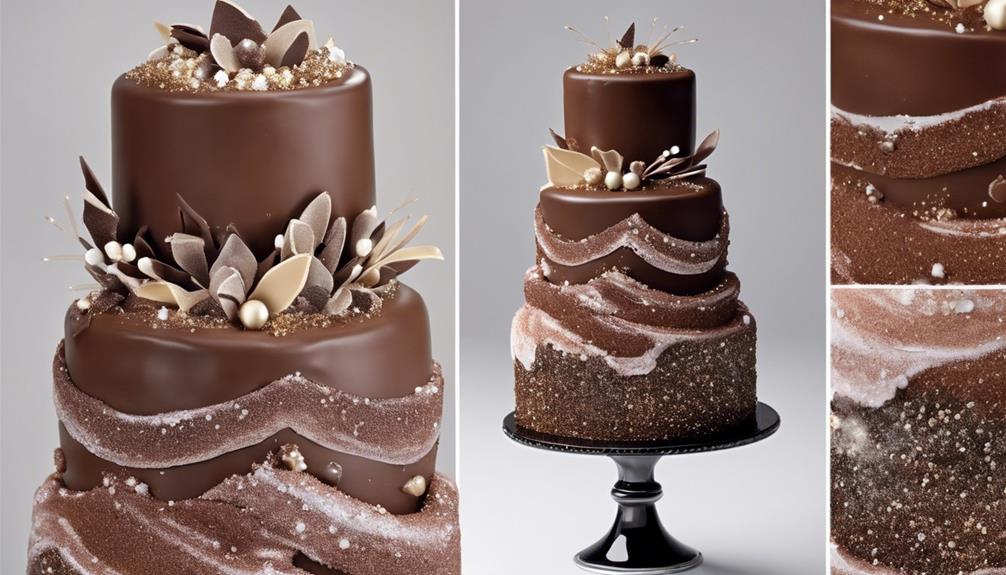
Sprinkling edible glitter onto a chocolate cake can instantly elevate its appearance with a touch of sparkle and glam. This simple yet effective decoration method is perfect for adding a magical and festive look to your frosted cakes.
To achieve this, lightly sprinkle edible glitter over the cake using either your fingers or a food-safe brush. The glitter comes in various colors and shapes, allowing you to customize the sparkle based on your preferences. For a more intricate touch, consider using the food-safe brush to apply the glitter in specific patterns or designs.
Experiment with different types of edible glitter, such as metallic, holographic, or matte finishes, to create unique decorations that will surely impress your guests. Remember, edible glitter is safe for consumption, so feel free to get creative and add some extra sparkle to your chocolate cake for a truly dazzling finish.
Chocolate Ganache Drip Technique
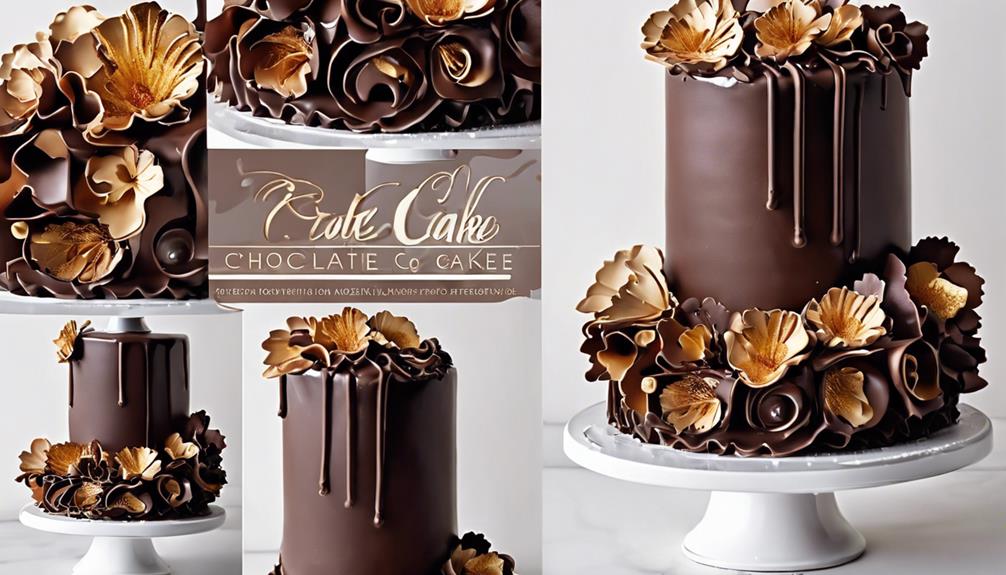
Adding a decadent touch to your chocolate cake, the Chocolate Ganache Drip Technique creates a luscious glossy coating that enhances both the look and taste of your creation.
To master this art, follow these steps:
- Prepare the Ganache: Heat cream until steaming, then pour over chopped chocolate. Stir gently until smooth to achieve a shiny glaze.
- Achieve the Right Consistency: Make sure the ganache is at a specific temperature for the perfect drip consistency. It should be warm but not too hot.
- Create Visual Appeal: Drip the ganache along the edges of the cake for a stunning visual effect. The drips should be even and elegant.
- Control Thickness: Adjust the thickness of the ganache by cooling it slightly before pouring. This will help you achieve the desired drip effect.
Adding Personalized Cake Toppers
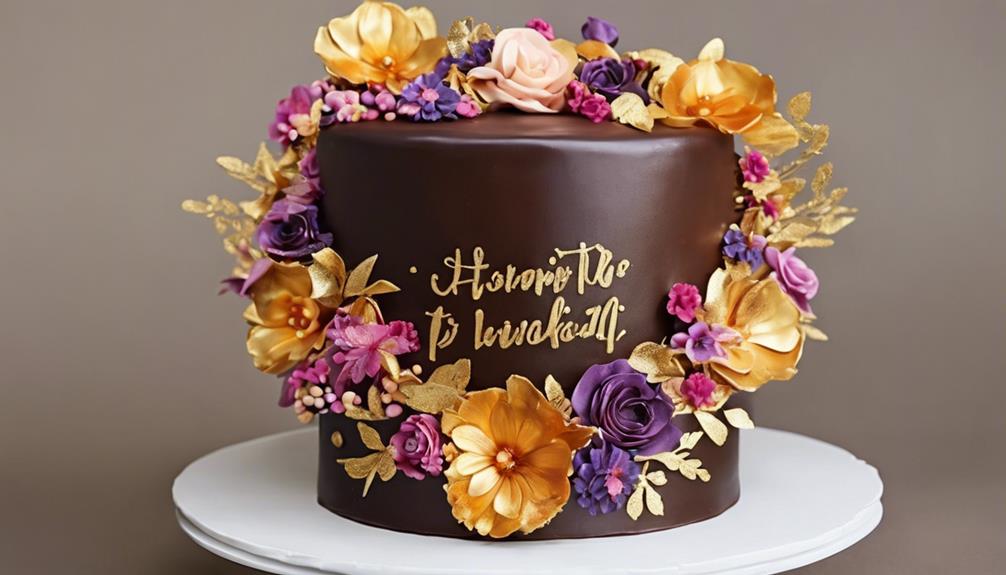
Crafting personalized cake toppers allows for a unique and memorable touch to any celebratory dessert. These toppers can be custom-made with names, dates, or special messages, adding a personal and distinctive element to your cake.
Depending on your preferences, cake toppers can be crafted from various materials such as acrylic, wood, or fondant, ensuring they complement the style of your cake.
By adding a personalized cake topper, you not only elevate the presentation of your dessert but also create a focal point that enhances the overall aesthetic of the celebration. Whether it's a wedding with elegant floral designs or a children's birthday with fun cartoon characters, themed toppers can be tailored to match the event seamlessly.
Additionally, these customized toppers can serve as keepsakes after the party, imbuing the decoration with sentimental value and lasting memories. Personalized cake toppers truly offer a creative way to make your cake stand out and leave a lasting impression on your guests.
Frequently Asked Questions
How to Decorate Chocolate Cake Ideas?
Decorating a chocolate cake is a delightful process. I love adding sprinkles, chocolate shavings, and even fresh fruit for a pop of color. Experimenting with different piping techniques and using edible flowers can truly elevate the cake's presentation.
How to Make Chocolate Shapes for Cake Decorating?
I melt chocolate, pour it into silicone molds, then chill for easy removal. Experimenting with shapes and colors livens up cake decorating. Adding luster dust brings shimmer. Creating chocolate shapes is fun and rewarding!
How to Decorate the Top of a Chocolate Cake With Strawberries?
I love decorating chocolate cake with strawberries! I slice them thinly, arrange in a beautiful pattern on top, and sometimes add a glaze or powdered sugar for extra flair. Whole strawberries with stems make a rustic centerpiece too.
What Flavors Go Well With Chocolate Cake?
When it comes to chocolate cake, flavors like vanilla, coffee, mint, raspberry, and caramel are like a symphony of contrasts that harmonize perfectly. They add depth and balance to the rich chocolate taste, creating a delightful culinary experience.
Can I Use the Ultimate Chocolate Cake Decoration Ideas for a Simple Cake Decoration?
Yes, you can definitely use the ultimate chocolate cake decoration ideas to decorate a chocolate cake. Whether you have a simple cake or a more elaborate one, these ideas can take your cake to the next level. From ganache drizzles to fresh fruit toppings, there are endless possibilities to beautify your chocolate creation.
Conclusion
To sum up, decorating a chocolate cake can be a fun and creative way to make your dessert stand out. Whether you choose to use chocolate curls, buttercream swirls, or edible flowers, there are endless possibilities to make your cake look beautiful and delicious.
Remember to have fun and experiment with different techniques to find what works best for you. With a little practice and creativity, you can create a stunning chocolate cake that will impress your friends and family.
Rachael, the Editor in Chief of RachaelsRawFood.com, is an inspiring and passionate individual who has dedicated her life to promoting the benefits of a raw food lifestyle. Known for her vibrant and energetic personality, Rachael has built a strong online presence that has transformed her personal journey into a thriving community of raw food enthusiasts.
Raw Food Ingredients
How Much Caffeine in Cocoa?
Not all cocoa products are created equal when it comes to caffeine content – discover which one might surprise you!

When evaluating the caffeine levels in cocoa, it’s important to recognize that dark chocolate contains around 43 mg of caffeine per 100 grams due to its high cocoa solid content. Dark chocolate has a higher caffeine content compared to milk or white chocolate. This means that consuming dark chocolate in moderation can assist in managing your caffeine intake. On the other hand, milk chocolate has around 20 mg of caffeine per 100 grams while white chocolate is caffeine-free. Cocoa powder, commonly used in baking and beverages, contains a substantial 230 mg of caffeine per 100 grams. Being aware of these distinctions in chocolates can help you make informed decisions about your caffeine consumption.
Key Takeaways
- Caffeine content in cocoa varies based on cocoa solid concentrations.
- Unsweetened cocoa powder can contain around 230 mg of caffeine per 100 grams.
- Roasting cocoa solids influences the final caffeine content in cocoa products.
- Dark chocolate, with high cocoa solid content, has more caffeine than milk chocolate.
- Moderate consumption of cocoa products helps manage caffeine intake.
Caffeine Content in Dark Chocolate
Dark chocolate boasts a caffeine content of approximately 43 mg per 100 grams, mainly deriving from its higher cocoa solid composition. When we indulge in this decadent treat, we aren't only savoring its rich cocoa flavor but also a subtle caffeine kick. Compared to milk or white chocolate, dark chocolate contains a higher amount of caffeine.
Please bear in mind that moderate consumption of dark chocolate can assist individuals in managing their caffeine intake effectively. The caffeine levels in dark chocolate are about one-fourth of what you'd find in a standard cup of coffee. So, if you're looking for a milder caffeine boost, a piece of dark chocolate might just do the trick without the jitters that sometimes accompany a strong cup of coffee.
Enjoy your dark chocolate in moderation, savoring both its taste and the gentle pick-me-up it provides.
Caffeine Levels in Milk Chocolate

Milk chocolate, known for its creamy texture and sweet flavor, contains a modest caffeine content of approximately 5.6 mg per ounce, as indicated by USDA data. Unlike dark chocolate, milk chocolate has a lighter color due to lower cocoa content, resulting in reduced caffeine levels.
The delightful creamy taste in milk chocolate comes from a harmonious blend of cocoa and milk powder. While dark chocolate boasts higher caffeine content, milk chocolate remains a popular choice for those seeking a sweet treat with minimal caffeine intake.
Caffeine Presence in White Chocolate
With its unique composition excluding cocoa solids, white chocolate stands out as a caffeine-free alternative to its darker counterparts. White chocolate is crafted from a blend of cocoa butter, milk powder, sugar, and vanilla, making it a delectable treat without the stimulating effects of caffeine. For individuals sensitive to caffeine, white chocolate offers a creamy texture and indulgent flavor without the worry of unwanted side effects. This makes it a popular choice for desserts among those looking to steer clear of caffeine in their sweet treats.
Compared to dark chocolate, which contains cocoa solids and hence caffeine, white chocolate provides a caffeine-free option for those seeking a more mellow indulgence. So, if you're in the mood for a luscious and smooth chocolate experience without the buzz of caffeine, white chocolate is the perfect choice for your next dessert delight.
Impact of Cocoa Solids on Caffeine

In determining the caffeine levels in cocoa products, the percentage of cocoa solids plays a significant role. Here are some key points about the impact of cocoa solids on caffeine content:
- Caffeine Derivation: The caffeine content in cocoa primarily comes from cocoa solids, making it an important factor in determining the overall caffeine levels in cocoa-based products.
- Dark Chocolate: Dark chocolate, known for its higher cocoa solid content, tends to contain more caffeine compared to milk or white chocolate varieties due to this higher concentration.
- Unsweetened Cocoa Powder: A 100g serving of unsweetened cocoa powder can contain around 230mg of caffeine, reflecting the impact of the high cocoa solid content in this form.
- Health Benefits: The roasting process of cocoa solids not only affects the flavor profile but also influences the caffeine content, contributing to the potential health benefits associated with consuming cocoa products like hot cocoa.
Comparing Caffeine in Different Chocolates
Comparing the caffeine content in different chocolates reveals varying levels based on their cocoa solid concentrations. Dark chocolate contains about 43 mg of caffeine per 100 grams, making it a stronger caffeinated option compared to milk chocolate, which only has around 20 mg per 100 grams.
Surprisingly, white chocolate, derived from cocoa butter, doesn't contain any caffeine at all. For those seeking a more potent caffeine kick, cocoa powder is the way to go, boasting a high concentration of 230 mg per 100 grams.
The amount of caffeine in chocolate products is closely linked to the cocoa solid content, with dark chocolate containing the highest levels. So, the next time you're craving a chocolate treat but also need a little energy boost, opt for dark chocolate to get the most caffeine per bite.
Frequently Asked Questions
Is There More Caffeine in Cocoa Than Coffee?
There's more caffeine in cocoa than in coffee. Cocoa powder packs 230 mg per 100 grams, surpassing most coffee varieties. Dark chocolate has even more caffeine due to higher cocoa content. It's a rich, unique energy source.
Is There a Lot of Caffeine in Hot Cocoa?
There isn't a lot of caffeine in hot cocoa. It depends on the brand and recipe. Starbucks hot chocolate has around 25 mg per serving, while basic mixes have about 5 mg. The amount of cocoa powder used influences the caffeine content.
Is There Caffeine in Hershey's Cocoa?
Absolutely, Hershey's Cocoa does contain caffeine, but it's not overwhelming. It adds a delightful hint of energy in each spoonful. Perfect for baking or a cozy cup of hot chocolate. Just the right amount!
Is Cocoa a Stimulant Like Caffeine?
Cocoa stimulates like caffeine due to its theobromine content. Decaf versions offer a solution for caffeine-sensitive folks. Options include regular cocoa with caffeine, Dutch-processed cocoa with less, and decaf cocoa with reduced caffeine while keeping healthful compounds.
What are the potential health effects of consuming high levels of caffeine in cocoa?
Unveiling cocoa caffeine levels can lead to potential health effects of excessive consumption. High levels of caffeine in cocoa may contribute to insomnia, nervousness, and fast heartbeat. It can also cause gastrointestinal discomfort and exacerbate anxiety disorders. Moderation in consuming caffeinated cocoa products is recommended for overall health.
Conclusion
To sum up, the caffeine content in cocoa varies depending on the type of chocolate. Dark chocolate typically has the highest caffeine levels, followed by milk chocolate and white chocolate. The amount of cocoa solids in the chocolate also affects the caffeine content.
Remember, just like different chocolates have different levels of caffeine, we all have unique strengths and abilities. Embrace your individuality and always aim for balance in everything you do.
Rachael, the Editor in Chief of RachaelsRawFood.com, is an inspiring and passionate individual who has dedicated her life to promoting the benefits of a raw food lifestyle. Known for her vibrant and energetic personality, Rachael has built a strong online presence that has transformed her personal journey into a thriving community of raw food enthusiasts.
Raw Food Ingredients
5 Key Differences: Caffeine Content in Cocoa Vs Coffee
Open the door to understanding the contrasting caffeine levels in cocoa and coffee, revealing surprising insights that will reshape your beverage choices.

When comparing the caffeine levels in cocoa and coffee, it is important to understand that cocoa generally has lower caffeine content than coffee. Dark chocolate contains approximately 12 milligrams of caffeine per ounce, while hot cocoa typically ranges from 5 to 10 milligrams per ounce. In contrast, brewed coffee can have significantly higher levels, varying from 95 to 165 milligrams per 8-ounce cup.
Cocoa is considered a milder option for individuals aiming to limit their caffeine intake, with theobromine providing a gradual energy increase. Meanwhile, coffee's caffeine content offers immediate alertness, and understanding these distinctions can help you select based on your preferred effects.
Key Takeaways
- Cocoa contains lower caffeine levels but compensates with theobromine for a gradual energy increase.
- Coffee has higher caffeine content, offering an immediate alertness boost and potentially higher metabolic rate.
- Theobromine in cocoa promotes relaxation, while caffeine in coffee provides intense alertness and mood fluctuations.
- Hot chocolate is a good option for reducing caffeine intake while still benefiting from theobromine effects.
- Understanding caffeine variances helps make informed choices for desired energy levels and mood effects.
Caffeine Levels in Cocoa Vs Coffee
When comparing caffeine levels in cocoa versus coffee, it's evident that cocoa generally contains lower amounts per serving. Dark chocolate, made from cacao beans, contains around 12 milligrams of caffeine per ounce, while a 1-ounce serving of hot cocoa mix typically has 5-10 milligrams. Even a 16-ounce serving of Starbucks hot chocolate only contains about 25 milligrams of caffeine.
On the other hand, coffee, when brewed, can range from 95 to 165 milligrams of caffeine per 8-ounce cup, depending on the type and brewing method. This significant difference in caffeine content between cocoa and coffee makes cocoa a milder option for those looking to limit their caffeine intake.
Impact on Alertness and Energy

Typically, the immediate alertness and energy boost from caffeine in coffee can last for hours. This surge in alertness is due to caffeine's stimulating effect on the central nervous system. On the other hand, cocoa contains theobromine, which provides a more gradual increase in energy levels. Unlike caffeine, theobromine doesn't cause sudden spikes and crashes, offering a smoother energy curve.
Coffee's caffeine content can temporarily boost the metabolic rate, potentially supporting weight management efforts. This increased metabolic rate can aid in burning calories and may contribute to weight loss when combined with a balanced diet and regular exercise. Additionally, theobromine in cocoa contributes to the thermogenic effect, leading to mild calorie burning in the body.
Both caffeine and theobromine can influence mood. Caffeine tends to provide a more intense and quick-acting mood elevation, while theobromine promotes feelings of relaxation and contentment. Understanding the differences in alertness, energy, metabolic effects, and mood enhancements between cocoa and coffee can help individuals make informed choices based on their preferences and wellness goals.
Metabolic Variances and Effects
Regarding metabolic variances and effects, the varying caffeine levels between cocoa and coffee play a significant role. When comparing the metabolic impact of caffeine in cocoa and coffee, it is crucial to note that cocoa contains lower levels of caffeine but compensates with theobromine, which aids in the thermogenic effect, promoting calorie burning and metabolic activity. On the other hand, coffee, especially brewed varieties, contains higher levels of caffeine, potentially providing a temporary boost to the metabolic rate, which could assist in weight management. While caffeine in coffee offers a quick energy surge, theobromine in cocoa leads to a more gradual rise in energy levels, avoiding sudden spikes and crashes. To summarize the metabolic differences, I've created a table below:
| Aspect | Cocoa | Coffee |
|---|---|---|
| Caffeine Content | Lower levels | Higher levels |
| Additional Component | Theobromine | Caffeine |
| Metabolic Impact | Thermogenic effect | Temporary metabolic rate boost |
| Energy Levels | Gradual rise | Quick surge |
| Weight Management | Aids in calorie burning | Potential assistance |
Mood Enhancement Disparities

In comparing the mood enhancement effects of theobromine in cocoa and caffeine in coffee, notable disparities emerge in their impact on mental well-being.
The theobromine found in cocoa promotes relaxation and contentment, offering a gradual rise in energy levels that leads to a gentle and long-lasting mood enhancement experience.
On the other hand, caffeine delivers an intense and fast-acting boost in alertness, providing immediate energy levels that can lead to abrupt spikes and crashes.
While both theobromine and caffeine uplift mood, theobromine's effects are characterized by a steady and gradual increase in energy levels, creating a sense of calm and contentment.
In contrast, caffeine's impact is more intense and temporary, resulting in rapid alertness but also the potential for fluctuations in mood. Understanding these differences can help individuals choose between cocoa and coffee based on their desired mood enhancement effects.
Health Implications and Considerations
Health implications and considerations surrounding caffeine consumption warrant close attention due to its potential impact on various aspects of well-being. When comparing a cup of coffee to hot chocolate, it's vital to note the amount of caffeine present.
While coffee contains much caffeine, hot chocolate has less caffeine but isn't entirely devoid of it. The main active ingredients in hot chocolate are theobromine and caffeine, where theobromine is a relative of caffeine and also has stimulant effects, although milder. If you're looking to reduce your caffeine intake, opting for hot chocolate over a cup of coffee can be a good choice.
Being mindful of the caffeine content in chocolate products is important, especially if you're sensitive to caffeine or belong to vulnerable populations like children or pregnant women. Understanding the caffeine levels in different beverages allows you to make informed decisions about your consumption for better overall health.
Frequently Asked Questions
Is There Caffeine in Coffee Vs Cacao Powder?
Yes, there is caffeine in coffee, with around 140 milligrams in a 12-ounce cup. On the other hand, cacao powder contains only about 12 milligrams per tablespoon, making it a great caffeine-free alternative for those seeking a milder boost.
What Is the Difference Between Cocoa and Coffee?
When comparing cocoa and coffee, cocoa offers a rich, chocolatey flavor and is packed with antioxidants and minerals. Coffee, on the other hand, provides a robust, bitter taste and a jolt of caffeine for that morning pick-me-up.
Why Is Cocoa Better Than Coffee?
I believe cocoa is superior to coffee because it offers a gentler energy boost, promotes relaxation and contentment, and provides sustained vitality without sudden crashes. Plus, dark chocolate's theobromine supports cellular health and tastes delicious.
How Much Caffeine Is in Cocoa Powder Vs Decaf Coffee?
In cocoa powder vs decaf coffee, cocoa has 12-26mg of caffeine per tbsp, while decaf coffee holds 2-5mg per 8-ounce cup. The choice hinges on desired caffeine levels and flavor. I prefer cocoa's lower caffeine content.
How does the caffeine content in hot chocolate compare to coffee?
Hot chocolate caffeine content is significantly lower than that of coffee. While an 8-ounce cup of hot chocolate contains about 5-10 milligrams of caffeine, the same size of coffee can have anywhere from 95-200 milligrams. It’s a notable difference for those looking to limit their caffeine intake.
Conclusion
To sum up, while cocoa and coffee both contain caffeine, the levels vary significantly. Cocoa generally has lower caffeine content compared to coffee, impacting alertness, energy levels, and mood enhancement differently.
It's crucial to keep these differences in mind when choosing between the two beverages for your daily consumption. Remember, moderation is key to maintaining a healthy balance in your caffeine intake.
So, whether you prefer a cup of cocoa or a mug of coffee, enjoy it in moderation for the best benefits!
Rachael, the Editor in Chief of RachaelsRawFood.com, is an inspiring and passionate individual who has dedicated her life to promoting the benefits of a raw food lifestyle. Known for her vibrant and energetic personality, Rachael has built a strong online presence that has transformed her personal journey into a thriving community of raw food enthusiasts.
Raw Food Ingredients
A Guide to Becoming a Good King
Kingship demands wisdom, fairness, integrity, courage, and humility – essential traits for a successful reign and prosperous kingdom." Keep reading to uncover the secrets of becoming a good king.

In order to be a good king, one must embody wisdom, fairness, integrity, courage, and humility to lead the kingdom with honor. Wisdom is essential for making important decisions, fairness ensures just treatment for all, integrity builds trust and respect, courage is crucial for facing challenges, and humility reminds us of our humanity. Historical kings such as Solomon, Arthur, David, Charlemagne, and Ramses II serve as role models for these leadership traits.
As a king, embracing challenges, understanding the world, seeking personal growth, and learning from the past are essential responsibilities. Developing leadership skills, making wise decisions, and prioritizing the well-being of the people are key to effective kingship. Every step on the path to becoming a good king is critical for a successful reign and prosperous kingdom.
Key Takeaways
- Embrace wisdom for informed decisions.
- Practice fairness for just treatment.
- Uphold integrity to earn trust.
- Show courage in facing challenges.
- Maintain humility for empathy and respect.
Qualities of a Good King
Being a good king requires embodying qualities such as wisdom, fairness, integrity, courage, humility, and compassion in decision-making and leadership. Power comes with responsibility, and as a king, it's essential to wield this power wisely. Wisdom is vital in making sound judgments that benefit the kingdom as a whole. Fairness guarantees that all subjects are treated justly and equitably, fostering a harmonious society. Integrity is the foundation of trust and respect, key elements in effective leadership.
Courage is necessary to face challenges and make difficult decisions, even when met with opposition. Humility reminds a king of his humanity and the importance of humility in interactions with all subjects. Compassion demonstrates a king's care and empathy towards his people, fostering a sense of unity and loyalty. Effective communication is crucial for conveying decisions, listening to concerns, and inspiring confidence in leadership.
Historical Kings as Role Models

King Solomon, renowned for his wisdom and leadership, stands as an exemplar among historical kings who serve as role models for future leaders. Looking at figures like King Arthur, known for his justice and valor in medieval legends, and King David, celebrated for his faith and courage in battle, we find lessons that transcend time. Charlemagne's legacy of military conquests and cultural revival, alongside Ramses II's grand building projects and military campaigns, offer diverse insights into effective kingship. Below is a table summarizing key attributes of these historical kings:
| King | Attributes |
|---|---|
| King Solomon | Wisdom, leadership |
| King Arthur | Justice, valor |
| King David | Faith, courage |
| Charlemagne | Military prowess, culture revival |
| Ramses II | Building projects, military campaigns |
Studying these historical figures can provide valuable lessons on the multifaceted qualities that make a great ruler.
Responsibilities of Kingship
Embracing challenges and living authentically are central to fulfilling the responsibilities inherent in kingship. As men aspiring to be good kings, it's essential for us to understand that the world requires leaders who are kind, humble, and committed to personal growth.
The journey to becoming a good king involves more than just wielding power and responsibility—it entails sacrificing comfort for growth and transformation. Seeking the ancient path of masculinity, as exemplified by figures like Morgan, teaches us the importance of humility, vulnerability, and character development.
In fulfilling the responsibilities of kingship, we're entrusted with power not for our own gain, but for the betterment of the world around us. Just as seeds need Good Soil to flourish, we must nurture our own growth to lead effectively.
Leadership Skills for Kings

Developing essential leadership skills is crucial for aspiring kings seeking to fulfill their responsibilities with humility, vulnerability, and a focus on character development. As you study the world around us, the power and responsibility of what kingship entails become clearer. Here are some key points to think about on your path to becoming a king:
- Embrace challenges and live authentically.
- Seek ancient paths of masculinity for guidance.
- Reflect on your identity, purpose, and ability to be entrusted with power for good.
- Sacrifice comfort for growth, transformation, and participation in universal creativity.
The journey of becoming a king isn't just about gaining authority but about understanding the remarkable fellowship of like-hearted individuals who share similar goals. Engage in group discussion questions, consider between-session personal study, and explore the depths of your masculine soul. This is the path to restoring what it means to be a true king.
Importance of Wise Decision-Making
Steering through the intricacies of leadership, especially in the domain of kingship, requires a sharp focus on the art of prudent decision-making. Wise decision-making is like the compass guiding the ship of leadership towards success.
Good kings understand that their choices impact not just themselves but also the lives of those they rule over. They prioritize the well-being of their people over personal gains, embodying the essence of true leadership.
Seeking counsel from trusted advisors and reflecting on core values are essential practices in the domain of wise decision-making. By embracing humility and self-awareness, kings can navigate the complex web of choices with clarity and integrity.
Just like a six-session video Bible study can guide individuals in restoring the heart, wise decision-making is essential for becoming the kind of leaders our world needs. Let's start on this journey of radical reconstruction, where every decision is a step towards being counted among the good kings of history.
Frequently Asked Questions
What Is the Becoming a King Guide?
The Becoming a King guide is a transformative resource created by Morgan Snyder to help men grow into responsible kings. It offers practical tools and profound insights to aid personal development and transformation.
What Are the Qualities of a Good King?
Being a good king means embodying humility, wisdom, and integrity. Prioritizing the well-being of my people, making decisions for the greater good, and showing courage, justice, and compassion in all actions. Seeking counsel and valuing diverse perspectives is essential.
What Makes a True King?
Beneath the crown lies a heart that beats with humility and a spirit that soars with honor. True kings are forged in the fires of challenge, embracing authenticity and growth to inspire others.
What Makes a Real King?
Being a true king means embodying humility, courage, and empathy. It's about serving others and leading with integrity. I endeavor to cultivate these qualities daily, embracing challenges and seeking growth in all aspects of my life.
How Can Sacred Cacao be Incorporated Into Kingship Rituals?
In kingship rituals, the sacred cacao ritual holds great significance. The ceremonial drinking of cacao symbolizes the divine connection between the ruler and the spiritual realm. It is believed to impart wisdom and strength, making it a crucial element in the coronation and leadership rites of many cultures.
Conclusion
To sum up, becoming a good king requires a combination of qualities, skills, and responsibilities. Remember, 'With great power comes great responsibility.'
By studying historical kings as role models, practicing leadership skills, and making wise decisions, one can aspire to be a just and effective ruler.
It's a challenging path, but with dedication and perseverance, anyone can endeavor to be a worthy leader for their kingdom.
Rachael, the Editor in Chief of RachaelsRawFood.com, is an inspiring and passionate individual who has dedicated her life to promoting the benefits of a raw food lifestyle. Known for her vibrant and energetic personality, Rachael has built a strong online presence that has transformed her personal journey into a thriving community of raw food enthusiasts.
-

 Raw Food Ingredients2 months ago
Raw Food Ingredients2 months agoHow To Make Hot Chocolate With Raw Cacao Powder
-

 Raw Food Ingredients2 months ago
Raw Food Ingredients2 months agoHow To Make Chocolate From Raw Cacao
-

 What is Raw Food?2 weeks ago
What is Raw Food?2 weeks agoHow To Remove Raw Mustard Oil Smell From Cooked Food
-

 Raw Food Ingredients4 weeks ago
Raw Food Ingredients4 weeks agoRaw Cacao Powder How Much For 8 Oz Hot Chocolate Recipe
-

 Raw Food Ingredients4 weeks ago
Raw Food Ingredients4 weeks agoThe Truth Behind the Cacao Caffeine Myth
-

 Raw Food Ingredients2 months ago
Raw Food Ingredients2 months agoWhen Fasting Can I Drink Coffee With Raw Cacao Powder
-

 What is Raw Food?2 weeks ago
What is Raw Food?2 weeks agoHow To Store Raw And Cooked Food Separately
-

 Raw Food Ingredients2 months ago
Raw Food Ingredients2 months agoHow To Use Raw Cacao Beans




